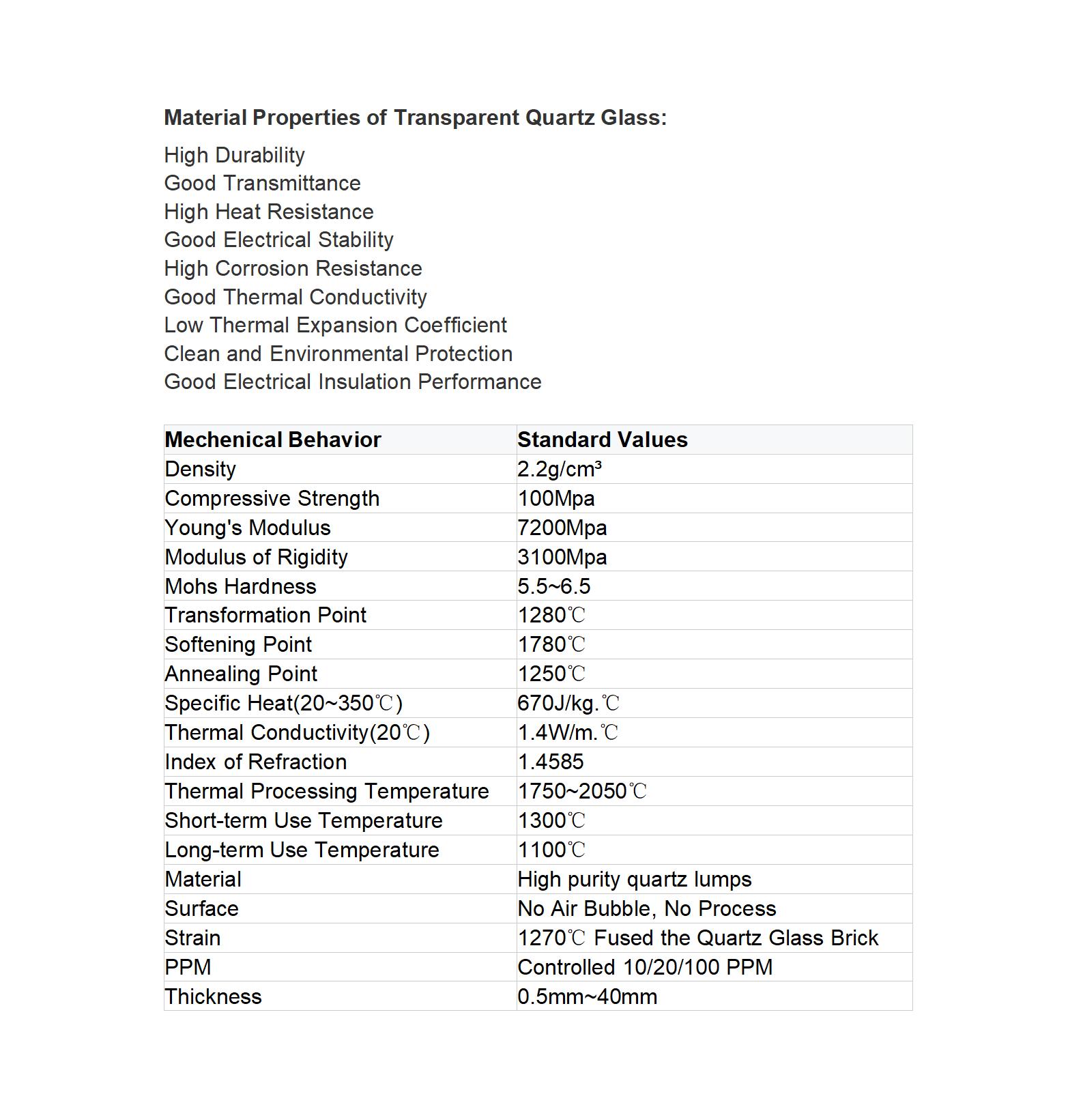T: +86-518-85528012
E: nick@luverrequartz.com
E: nick@luverrequartz.com
1st floor Runlian industrial center No. 116 QuFeng Rd., Haizhou Economic and technological development zone Lianyungang City, Jiangsu Province, China 222062
Visible spectrum quartz glass disc
Visible spectrum quartz glass disc, depending on different types, such as JGS1 JGS2、JGS3, Having their own unique optical properties.
LUVERRE quartz
99.99%
Inner with Vacuum PVC bag and then wrapped with air bubble film, outer with wooden box.
as per customer's requirement
| Availability: | |
|---|---|
Visible spectrum quartz glass disc
Visible spectrum quartz glass disc, depending on different types, such as JGS1 JGS2、JGS3, Having their own unique optical properties. These quartz glass types are transparent in the ultraviolet and visible spectral ranges, with advantages such as high temperature resistance, low thermal expansion coefficient, and good chemical stability, making them suitable for optical applications under various unfavorable conditions.
JGS1 quartz glass: There is no absorption band in the 185-2500nm wavelength range, but there is a strong absorption band in the 2600-2800nm wavelength range. It is non luminous, with stable light radiation.
JGS2 quartz glass: There is no absorption band in the 200-2500nm wavelength range, and there is also a strong absorption band in the 2600-2800nm wavelength range.
JGS3 quartz glass: Transparent in visible and infrared spectra, with no obvious absorption band in the 2600-2800nm wavelength range.

These types of quartz glass have excellent transmission performance over the entire wavelength range compared to ordinary silicate glass. In the infrared region, the spectral transmittance of quartz glass is higher than that of ordinary glass, and in the visible region, the spectral transmittance of quartz glass is also higher. In the ultraviolet band, especially in the short wave band, the multispectral transmittance is influenced by three factors: reflection, scattering, and absorption, and is superior to other glasses. The reflection of quartz glass is generally 8%, with a larger ultraviolet region and a smaller infrared region. Therefore, the transmittance of quartz glass generally does not exceed 92%. The scattering of quartz glass is very small and can be ignored.
Spectral absorption is closely related to the impurity content and production process of quartz glass. For example, the transmittance below 200nm represents the content of metal impurities, the absorption in the 240nm band represents oxygen deficient structures, and the absorption in the visible band is caused by the presence of transition metal ions.

Visible spectrum quartz glass discs play an important role in optical applications due to their excellent optical properties and stability.
Visible spectrum quartz glass disc
Visible spectrum quartz glass disc, depending on different types, such as JGS1 JGS2、JGS3, Having their own unique optical properties. These quartz glass types are transparent in the ultraviolet and visible spectral ranges, with advantages such as high temperature resistance, low thermal expansion coefficient, and good chemical stability, making them suitable for optical applications under various unfavorable conditions.
JGS1 quartz glass: There is no absorption band in the 185-2500nm wavelength range, but there is a strong absorption band in the 2600-2800nm wavelength range. It is non luminous, with stable light radiation.
JGS2 quartz glass: There is no absorption band in the 200-2500nm wavelength range, and there is also a strong absorption band in the 2600-2800nm wavelength range.
JGS3 quartz glass: Transparent in visible and infrared spectra, with no obvious absorption band in the 2600-2800nm wavelength range.

These types of quartz glass have excellent transmission performance over the entire wavelength range compared to ordinary silicate glass. In the infrared region, the spectral transmittance of quartz glass is higher than that of ordinary glass, and in the visible region, the spectral transmittance of quartz glass is also higher. In the ultraviolet band, especially in the short wave band, the multispectral transmittance is influenced by three factors: reflection, scattering, and absorption, and is superior to other glasses. The reflection of quartz glass is generally 8%, with a larger ultraviolet region and a smaller infrared region. Therefore, the transmittance of quartz glass generally does not exceed 92%. The scattering of quartz glass is very small and can be ignored.
Spectral absorption is closely related to the impurity content and production process of quartz glass. For example, the transmittance below 200nm represents the content of metal impurities, the absorption in the 240nm band represents oxygen deficient structures, and the absorption in the visible band is caused by the presence of transition metal ions.

Visible spectrum quartz glass discs play an important role in optical applications due to their excellent optical properties and stability.